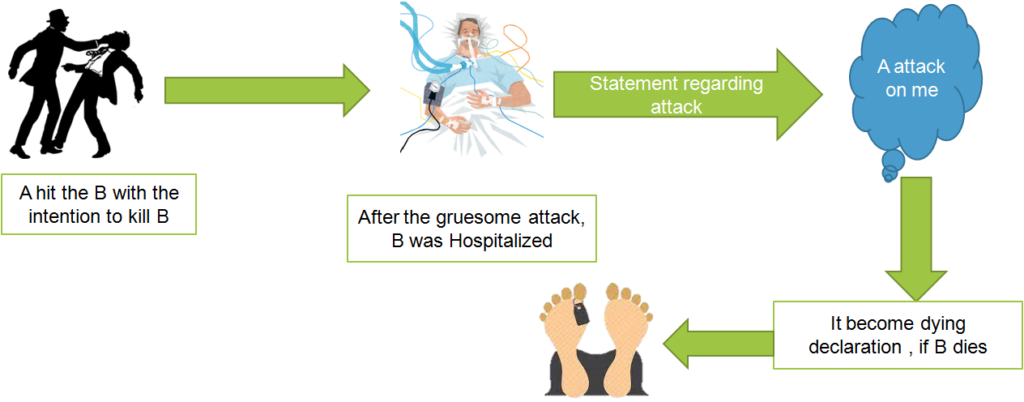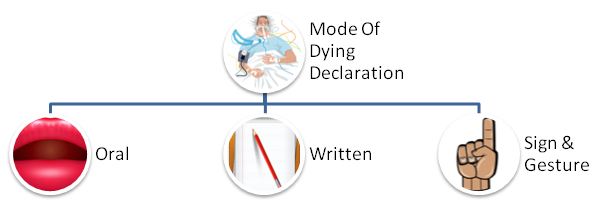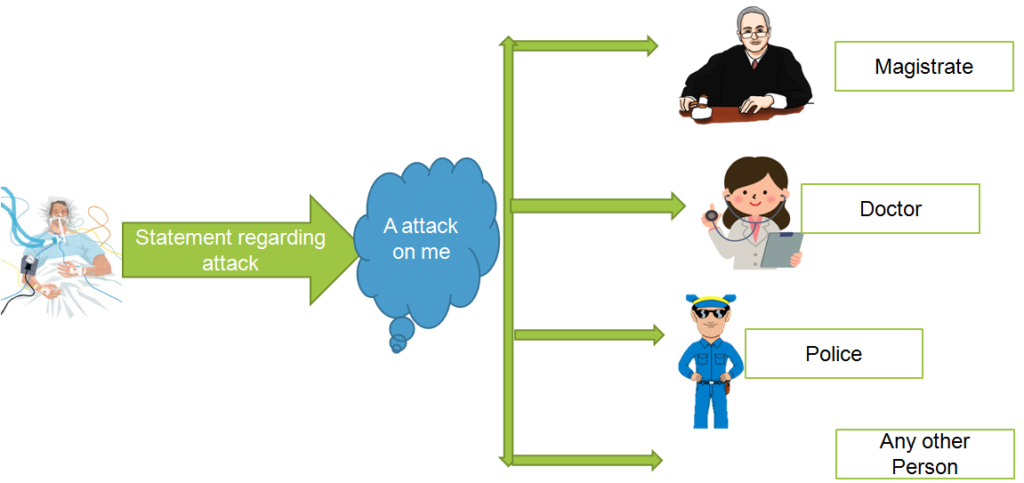Section – 32 (1) of Evidence Act
Dying Declaration

Dying Declaration Under Section 32
Illustration -2 When Person survives , the Statement is not Considered to be a Dying Declaration

Dying Declaration Under Section 32
- Section -32. Cases in which statement of relevant fact by person who is dead or cannot be found, etc, is relevant
- Statements, written or verbal, or relevant facts made by a person who is dead, or who cannot be found, or who has become incapable of giving evidence, or whose attendance cannot be procured without an amount of delay or expenses which, under the circumstances of the case, appears to the Court unreasonable, are themselves relevant facts in the following cases:-
- (1) When it relates to cause of death—When the statement is made by a person as to the cause of his death, or as to any of the circumstances of the transaction which resulted in his death, in cases in which the cause of that person’s death comes into question.
- Such statements are relevant whether the person who made them was or was not, at the time when they were made, under expectation of death, and whatever may be the nature of the proceeding in which the cause of his death comes into question.
- Sec 32 and 33 of the Indian Evidence Act provides an exception to the heresay rule. Sec 32(1) is one of that exception under which a statement of deceased is admissible if it is related to cause of his death or the circumstances which resulted in his death, in a case when cause of death of such person is in question. Such statement is called as ‘dying declaration’
Essentials of the Dying declaration to be relevant
- Person making statement must die and cause of his death is in question before the Court
- Statement must relate to the cause of his death or the circumstances of the transaction which resulted his death
- Statement can be made with or without expectation of death
- Person making statement must die and cause of his death is in question before the Court
As dying declaration is a statement of a person about the cause of his death’ or ‘circumstances which resulted in his death’ in case where his death is in ‘question’.
The death may be caused by either homicide or suicide
Therefore if a person survived after making such statement, such is not dying declaration.
Statement of deceased is dying declaration.
Therefore the death of the person making statement must be proved before the Court to use the statement of the person making it as ‘dying declaration’ under sec 32(1).
If such person survived after making statement as ‘dying declaration’ such statement later may be used to corroborate the testimony of the person making it under sec 157 of the Indian evidence Act or to contradict him under sec 145 of the Indian Evidence Act
- Statement must relate to the cause of his death or the circumstances of the transaction which resulted his death
The expression cause of death’ is concerned with reason of the death of the person making the statement. For example, A makes a statement that B assaulted him with spear and died. Such statement of A is admissible as ‘dying declaration’ in the case where cause of death of A is in question.
The immediate death is not required, If A dies after some time, it don’t affect the nature of ‘dying declaration’ because cause of the death was the injury given by the B. As held in Moti Singh v State of UP AIR 1964 SC 900 the death of the person making statement caused by the injury he received in the incident for which accused is being prosecuted
A was tried for the murder of B. B narrated the story of his death to the Police. But in medical examination the reason of the death was’ kidney disease’. The statement of the B is not admissible as dying declaration.
For example, a married woman had been writing to her parents and other relatives about her critical condition at the hands of her inlaws. She lost her life after four months later. Her letters were held to be admissible as dying declaration.(Sharda Birdhi chand Sharda v State of Maharastra AIR 1984 SC 1622).
- Statement can be made with or without expectation of death
If the statement has direct relation to the cause or the occasion of the death of a deceased, it is immaterial that it made before the person has received any injury or before the cause of death raised or before the deceased has any reason to anticipation of being killed.
For example Where the fact in issue was whether A had committed murder of B. Statement of B before he was assaulted that A has taken cash and ornament form him and that he going there to demand , is admissible as dying declaration.(Jainand v Rex AIR 1976 ALL 291)
Section – 32 (1) of Evidence Act
Forms of Dying declaration

Dying Declaration Under Section 32
There is no particular form to be required in making dying declaration. It may be in oral or writing, or even may be partly oral or partly writing. It may be if form of signs or gesture by the deceased. (Queen Empress v Abdullah, ILR(1885)7 All 385
In Queen-Empress v. Abdullah (1885 ILR 7 ALL 385): Accused had cut the throat of the deceased girl and because of that, she was not able to speak. So she indicated the name of the accused by the signs of her hand.
There is no particular form of dying declaration. But crucial factors such as to who had stabbed the deceased and what are required to be included in the dying declaration. A dying declaration may be in the following forms:
- Written form;
- Verbal form;
- Gestures and Signs form;
- A dying declaration may be in the form of narrations. It is preferred that it should be written in the vernacular which the patient understands and speaks.

Oral Dying Declaration
The Hon’ble Apex Court emphasized the need for corroboration of such declaration particularly in a case of this kind where the oral statement was made by the injured person to his mother and she being an interested witness. Such declaration has to be considered with care and caution.
A statement made orally by the person who was struck down with a stick blow on head and which was narrated by the witness who lodged the F.I.R. as a part of the F.I.R. was accepted as a reliable statement for the purpose of Section 32.
In case an injured person lodged the FIR and died, it is dying declaration. (K. Ramchand Reddy v Public Prosecutor (1976) 3SCC 104.
Same in case where complaint made to police is relating to cause of death or circumstances of the transaction which resulted death of the maker is dying declaration(Jai Prakash v state of Haryana1999 Cr LJ 837 SC )
Watch this topic – Section – 32 (1) of Evidence Act – Dying Declaration Part 1 on YouTube








No comment